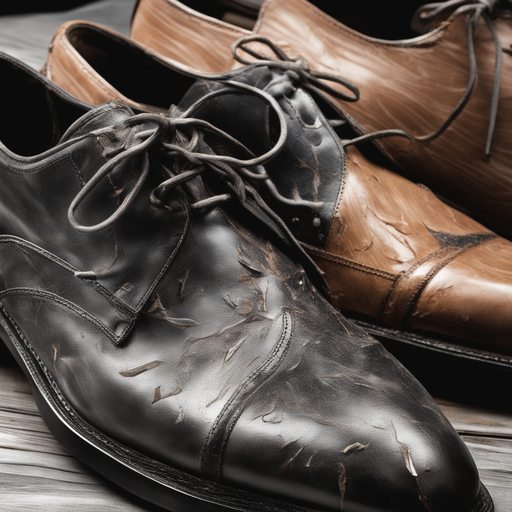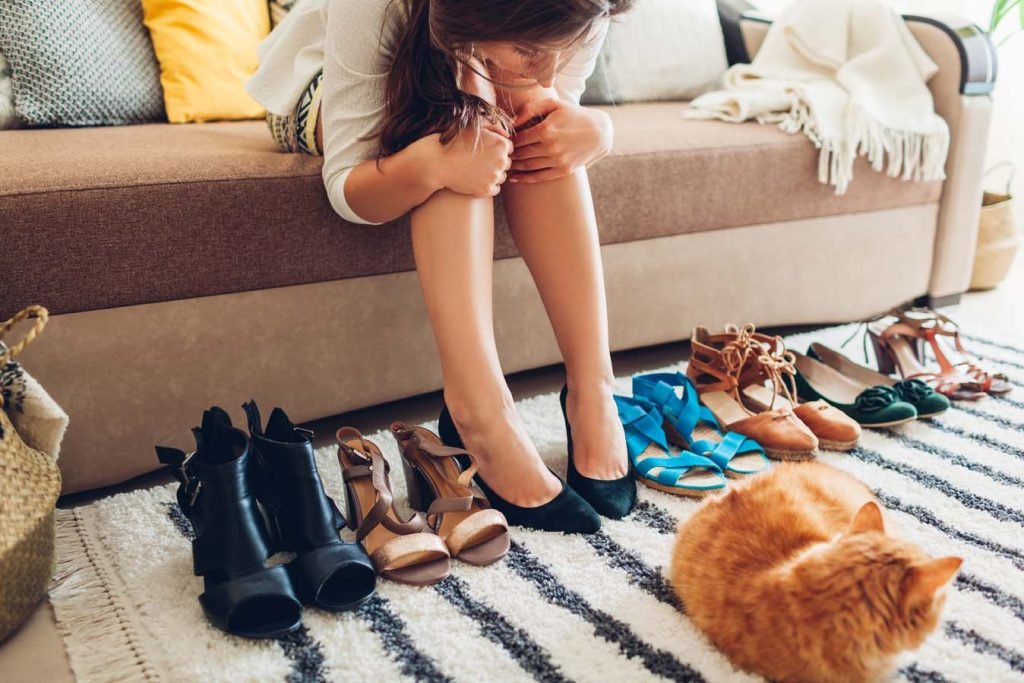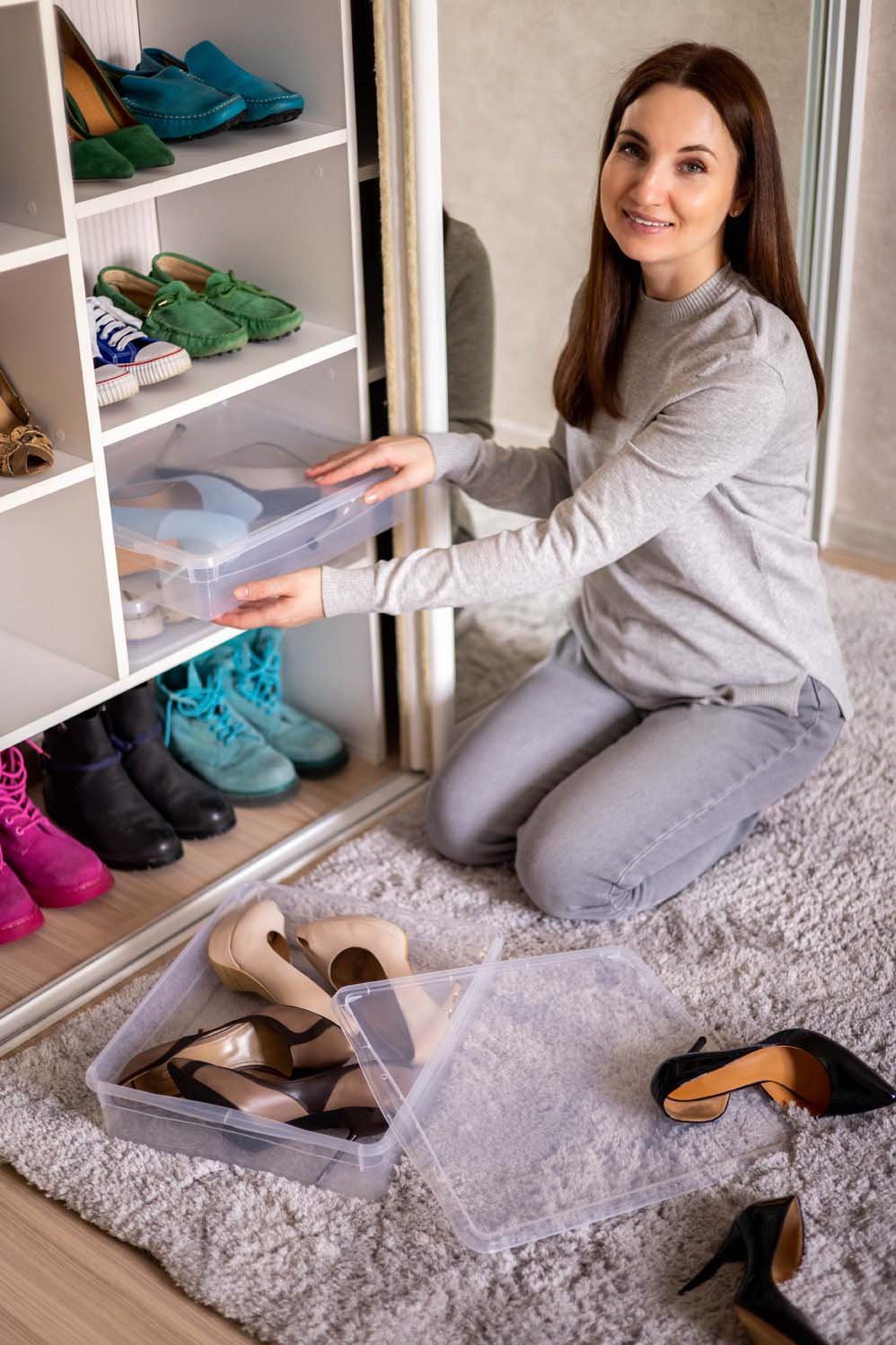Shoes are not just a practical and functional necessity; they are an integral part of our daily lives and also a statement of style and personality. They keep our feet comfortable, supported, and stylish.
Whether it’s a pair of sleek leather oxfords or comfortable running shoes, each pair deserves to be treated with care.
However, many of us overlook the importance of proper shoe storage, inadvertently subjecting our beloved footwear to potential damage.
It might seem like a small detail, but how you store your shoes can have a significant impact on their lifespan and overall condition.
In this article, we will delve into the various ways shoes can suffer when not stored correctly, emphasizing the significance of mindful shoe care and the importance of implementing shoe storage solutions.
We will dive headfirst into the world of shoe care and storage, uncovering the hidden dangers of neglecting this crucial aspect of footwear maintenance. From scuffed leather to misshapen soles, there’s a whole host of hazards that await your shoes if they’re not given the proper TLC they deserve.
- Introduction
- 1. Preserving Shape and Structure
- 2. Avoiding Scratches and Scuffs
- 3. Preventing Color Fading and Deterioration
- 4. Promoting Air Circulation and Avoiding Moisture and Mildew
- 5. Organizing Your Collection
- 6. Preventing Insect and Pest Infestations
- 7. Sole Separation and Material Degradation
- 8. Loss of Support and Cushioning
- 9. Loss of Value for Collectible or High-End Shoes
- Conclusion
Introduction
If you’re anything like me, you’ve probably amassed a collection of footwear that would make even Cinderella green with envy. Whether it’s those sleek leather oxfords or those comfy sneakers you practically live in, we all know that our shoes are more than just foot coverings—they’re an expression of our style and personality.
But hold on a second, have you ever stopped to think about how you’re storing these cherished possessions? It might sound like a small detail, but improper shoe storage can lead to some serious problems. Trust me, I’ve learned the hard way, and it’s not a fun lesson to learn.
Picture this: a pile of shoes stacked haphazardly in the corner of your closet. Sure, it might seem convenient, but it’s a disaster waiting to happen. Those expensive leather boots rubbing against each other, the heels of your favorite pumps getting chipped, and the arch support of your running shoes getting squished—it’s a shoe catastrophe in the making!
Now, let’s talk moisture. Shoes are no fans of dampness, and yet, they often find themselves trapped in dark, humid spaces. Imagine the horror your suede loafers go through when left to marinate in their own perspiration. It’s a breeding ground for mold and odors, and trust me, nobody wants to be the owner of stinky, moldy shoes.
And if you think that’s bad, wait till you hear about the dangers of sunlight. Those warm rays streaming through your window might be a mood lifter for you, but for your shoes, it’s a recipe for disaster. Colors fade, materials weaken, and before you know it, your once vibrant pair of heels is a shadow of its former self.
But fret not, my fellow footwear aficionado, because in this guide, we’re going to equip you with all the knowledge you need to save your shoes from these perils. We’ll be delving into the art of proper shoe storage, from the ideal shelving solutions to the nitty-gritty of temperature and humidity control.
So, whether you’re an avid collector or just someone who wants to get the most out of their favorite pair, this guide is tailor-made for you. Let’s embark on this journey together, because your shoes deserve nothing but the best.
Say goodbye to scuffs, molds, and faded colors, and say hello to a shoe collection that stands the test of time. Get ready to step into a world of shoe care wisdom!
1. Preserving Shape and Structure
One of the most immediate benefits of proper shoe storage is preserving the shape and structure of your footwear as deformation is one of the most noticeable consequences of improper shoe storage.
Shoes are designed with specific contours and shapes that provide comfort and support to your feet. When they’re stored in a manner that puts undue pressure on them— such as stacking or cramming them into tight spaces, they can become misshapen that are uncomfortable to wear.
The result?
A pair of shoes that not only looks unattractive but also fails to provide the comfort they were designed for.
Investing in a shoe rack or shelving system that allows for individual placement of each pair is a simple yet effective way to prevent this kind of damage.
This not only enhances the longevity of your shoes but also ensures they remain comfortable to wear.
By giving each shoe its own designated space, you safeguard their structure and extend their lifespan.

2. Avoiding Scratches and Scuffs
Shoes, especially those made of delicate materials like suede or patent leather, are susceptible to scratches and scuffs. When stored haphazardly, shoes can rub against each other or against hard surfaces, leading to unsightly blemishes.
These imperfections not only compromise the aesthetic appeal of your shoes but can also be challenging and expensive to repair.
A proper shoe storage solution provides a designated space for each pair, reducing the risk of unwanted contact that can mar the appearance of your beloved footwear.
Consider using individual shoe bags or compartments to create a protective barrier between your footwear and potential sources of abrasion.
3. Preventing Color Fading and Deterioration
Exposure to direct sunlight or harsh artificial light is a common issue and can cause the color of your shoes to fade over time.
This is particularly noticeable with vibrant or richly dyed materials. Over time, prolonged exposure to UV rays can cause colors to lose their vibrancy, leaving your shoes looking dull and lackluster.
Proper shoe storage should take into account factors like light exposure.
Ideally, shoes should be stored in a cool, dark place away from direct sunlight. This not only helps maintain their original color but also prevents any potential damage caused by UV rays.
Implementing this simple precaution can significantly prolong the lifespan of your footwear.
4. Promoting Air Circulation and Avoiding Moisture and Mildew
Shoes, especially those worn frequently, can accumulate moisture from your feet. Without proper ventilation, this moisture can lead to unpleasant odors and even damage to the materials.
Moisture and humidity are the enemies of many types of footwear. Leather, in particular, is highly susceptible to damage from excess moisture.
When shoes are not stored in a dry, well-ventilated environment, they can become prone to mold, mildew, and water stains.
This not only compromises their appearance but can also weaken the structural integrity of the material.
Storing shoes in a well-ventilated area, or using breathable shoe bags, allows air to circulate around the footwear, helping to prevent microbial growth and prolonging their freshness.
Additionally, inserting shoe trees or crumpled newspaper can absorb excess moisture, maintaining the integrity of the materials.
Investing in a dehumidifier or using moisture-absorbing products in your storage area can help combat this issue.
Additionally, if your shoes do get wet, make sure to allow them to air dry thoroughly before storing them to prevent further damage.

5. Organizing Your Collection
How many times have you gone looking for the right pair of shoes only to not know where they are located?
This can cause frustration beyond belief especially when you are in a time crunch.
By creating a well-organized shoe storage system, you can not only protect your shoes but also make it easier for you to find and access them.
No more digging through piles or searching for the elusive matching pair!
With a designated place for each pair of shoes, you can quickly select the perfect footwear for any occasion.
6. Preventing Insect and Pest Infestations
Improperly stored shoes can be an attractive hiding spot for pests like insects and rodents. Dark, warm and undisturbed areas provide an ideal environment for these unwelcome visitors.
Not only can they damage the shoes themselves, but they can also create unsanitary conditions.
Investing in sealed shoe storage containers or placing shoes on elevated surfaces can help prevent infestations and keep your footwear safe.
Regular inspections and cleaning of your storage area can further safeguard your footwear from these potential threats.
7. Sole Separation and Material Degradation
Normal to excessive wear and tear of your shoes can eventually lead to sole separation and material degradation. Shoes are subject to constant pressure, especially in areas that bear the brunt of your weight.
When stored improperly, this pressure can cause the adhesive holding the sole to weaken and eventually fail.
As a result, you may find yourself facing the frustrating and costly issue of having to re-sole your favorite pair. Furthermore, materials like leather, suede, and canvas require proper airflow to maintain their integrity.
Storing them in cramped, airless spaces can cause these materials to become brittle and prone to cracking or tearing. This is particularly true for natural materials that rely on moisture balance to stay supple and durable.
To combat this, opt for storage solutions that allow for adequate airflow. Avoid cramming shoes tightly together, and consider using shoe trees to help maintain their shape and structure.
Additionally, periodically inspect your shoes for any signs of deterioration, and address any issues promptly to prevent further damage.
8. Loss of Support and Cushioning
Have you ever had a pair of shoes that were comfortable to wear when you first got them but as time went by they slowly lost their support?
Shoes, especially those designed for specific activities like running or hiking, often come equipped with specialized support and cushioning systems.
Over time, improper storage can lead to these features degrading or losing their effectiveness. This means that when you put on your shoes, they may no longer provide the level of comfort and support you initially enjoyed.
To avoid this, consider storing your shoes in a way that maintains their natural shape and structure.
Avoid placing heavy items on top of them, and refrain from folding or compressing them for extended periods.
Additionally, make sure to remove any excess dirt or debris from your shoes before storing them, as this can contribute to premature wear.
9. Loss of Value for Collectible or High-End Shoes
For those who appreciate high-end or collectible footwear, improper storage can have significant financial implications.
Rare or designer shoes can be valuable investments, and their condition plays a crucial role in determining their resale value.
Storing them improperly can lead to irreversible damage, greatly reducing their worth.
To protect your investment, consider using specialized shoe storage solutions designed for high-end footwear.
These may include dust bags, climate-controlled cabinets, or custom-made displays.
Additionally, regular maintenance, such as cleaning and conditioning, can help preserve the value of your collectible shoes.
Conclusion
Proper shoe storage is not just about aesthetics; it’s about safeguarding the longevity, comfort, and value of your footwear. It is often underestimated aspect of shoe care.
Failing to store your shoes correctly can lead to a range of problems, from deformations and scratches to color fading and even pest infestations. By investing in the right storage solutions and adopting simple preventative measures, you can ensure your footwear always remains stylish, comfortable, and in excellent condition.
Recognizing the potential risks of improper storage and taking proactive measures to protect your shoes, can save you from the disappointment of damaged or devalued shoes in the future.
While it might seem like a small detail, but it plays a crucial role in preserving the condition and longevity of your footwear.
Your feet—and your wallet—will thank you.

